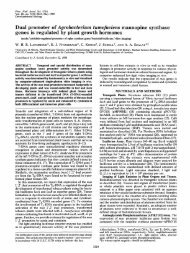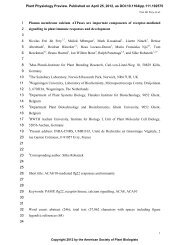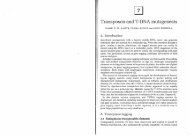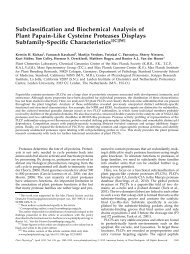A Conserved Domain of the Arabidopsis GNOM ... - The Plant Cell
A Conserved Domain of the Arabidopsis GNOM ... - The Plant Cell
A Conserved Domain of the Arabidopsis GNOM ... - The Plant Cell
You also want an ePaper? Increase the reach of your titles
YUMPU automatically turns print PDFs into web optimized ePapers that Google loves.
356 <strong>The</strong> <strong>Plant</strong> <strong>Cell</strong><br />
Moss, J., and Vaughan, M. (1998). Molecules in <strong>the</strong> ARF orbit. J.<br />
Biol. Chem. 273, 21431–21434.<br />
Mücke, M., and Schmid, F.X. (1994). Folding mechanism <strong>of</strong> ribonuclease<br />
T1 in <strong>the</strong> absence <strong>of</strong> <strong>the</strong> disulfide bonds. Biochemistry 33,<br />
14608–14619.<br />
Page, A.P., MacNiven, K., and Hengartner, M.O. (1996). Cloning<br />
and biochemical characterization <strong>of</strong> <strong>the</strong> cyclophilin homologues<br />
from <strong>the</strong> free-living nematode Caenorhabditis elegans. Biochem.<br />
J. 317, 179–185.<br />
Peyroche, A., Paris, S., and Jackson, C.L. (1996). Nucleotide<br />
exchange on ARF mediated by yeast Gea1 protein. Nature 384,<br />
479–481.<br />
Price, E.R., Jin, M., Lim, D., Pati, S., Walsh, C.T., and McKeon,<br />
F.D. (1994). Cyclophilin B trafficking through <strong>the</strong> secretory pathway<br />
is altered by binding <strong>of</strong> cyclosporin A. Proc. Natl. Acad. Sci.<br />
USA 91, 3931–3935.<br />
Prodromou, C., Siligardi, G., O’Brien, R., Woolfson, D.N., Regan,<br />
L., Panaretou, B., Ladbury, J.E., Piper, P.W., and Pearl, L.H.<br />
(1999). Regulation <strong>of</strong> Hsp90 ATPase activity by tetratricopeptide<br />
repeat (TPR)-domain co-chaperones. EMBO J. 18, 754–762.<br />
Saito, T., Niwa, Y., Ashida, H., Tanaka, K., Kawamukai, M., Matsuda,<br />
H., and Nakagawa, T. (1999). Expression <strong>of</strong> a gene for cyclophilin<br />
which contains an amino-terminal endoplasmic reticulum–targeting<br />
signal. <strong>Plant</strong> <strong>Cell</strong> Physiol. 40, 77–87.<br />
Sambrook, J., Fritsch, E.F., and Maniatis, T. (1989). Molecular<br />
Cloning: A Laboratory Manual, 2nd ed. (Cold Spring Harbor, NY:<br />
Cold Spring Harbor Laboratory Press).<br />
Sata, M., Donaldson, J.G., Moss, J., and Vaughan, M. (1998).<br />
Brefeldin A–inhibited guanine nucleotide-exchange activity <strong>of</strong><br />
Sec7 domain from yeast Sec7 with yeast and mammalian ADP<br />
ribosylation factors. Proc. Natl. Acad. Sci. USA 95, 4204–4208.<br />
Sato, S., Kaneko, T., Kotani, H., Nakamura, Y., Asamizu, E.,<br />
Miyajima, N., and Tabata, S. (1998). Structural analysis <strong>of</strong> <strong>Arabidopsis</strong><br />
thaliana chromosome 5. IV. Sequence features <strong>of</strong> <strong>the</strong><br />
regions <strong>of</strong> 1,456,315 bp covered by nineteen physically assigned<br />
P1 and TAC clones. DNA Res. 5, 41–54.<br />
Schönbrunner, E.R., Mayer, S., Tropschug, M., Fischer, G.,<br />
Takahashi, N., and Schmid, F.X. (1991). Catalysis <strong>of</strong> protein folding<br />
by cyclophilins from different species. J. Biol. Chem. 266,<br />
3630–3635.<br />
Schumacher, A., Westermann, B., Osborn, M., and Nordheim, A.<br />
(1994). <strong>The</strong> N-terminal signal peptide <strong>of</strong> <strong>the</strong> murine cyclophilin<br />
mCyP-S1 is required in vivo for ER localization. Eur. J. <strong>Cell</strong> Biol.<br />
63, 182–191.<br />
Sheldon, P.S., and Venis, M.A. (1996). Purification and characterization<br />
<strong>of</strong> cytosolic and microsomal cyclophilins from maize (Zea<br />
mays). Biochem. J. 315, 965–970.<br />
Shevell, D.E., Leu, W.M., Gillmor, C.S., Xia, G., Feldmann, K.A.,<br />
and Chua, N.H. (1994). EMB30 is essential for normal cell division,<br />
cell expansion, and cell adhesion in <strong>Arabidopsis</strong> and<br />
encodes a protein that has similarity to Sec7. <strong>Cell</strong> 77, 1051–1062.<br />
Springer, S., Spang, A., and Schekman, R. (1999). A primer on<br />
vesicle budding. <strong>Cell</strong> 97, 145–148.<br />
Steinmann, T., Geldner, N., Grebe, M., Mangold, S., Jackson,<br />
C.L., Paris, S., Gälweiler, L., Palme, K., and Jürgens, G. (1999).<br />
Coordinated polar localization <strong>of</strong> auxin efflux carrier PIN1 by<br />
<strong>GNOM</strong> ARF GEF. Science 286, 316–318.<br />
Telemenakis, I., Benseler, F., Stenius, K., Südh<strong>of</strong>, T.C., and<br />
Brose, N. (1997). Rat homologues <strong>of</strong> yeast Sec7p. Eur. J. <strong>Cell</strong><br />
Biol. 74, 143–149.<br />
<strong>The</strong>riault, Y., Logan, T.M., Meadows, R., Yu, L., Olejniczak, E.T.,<br />
Holzman, T.F., Simmer, R.L., and Fesik, S.W. (1993). Solution<br />
structure <strong>of</strong> <strong>the</strong> cyclosporin A/cyclophilin complex by NMR.<br />
Nature 361, 88–91.<br />
Thompson, J.D., Higgins, D.G., and Gibson, T.J. (1994). CLUSTAL<br />
W: Improving <strong>the</strong> sensitivity <strong>of</strong> progressive multiple sequence<br />
alignment through sequence weighting, positions-specific gap<br />
penalties and weight matrix choice. Nucleic Acids Res. 22, 4673–<br />
4680.<br />
Wee, E.G.-T., Sharrier, D.J., Prime, T.A., and Dupree, P. (1998).<br />
Targeting <strong>of</strong> active sialyltransferase to <strong>the</strong> plant Golgi apparatus.<br />
<strong>Plant</strong> <strong>Cell</strong> 10, 1759–1768.<br />
Weiss, A., and Schlessinger, J. (1998). Switching signals on or <strong>of</strong>f<br />
by receptor dimerization. <strong>Cell</strong> 94, 277–280.<br />
NOTE ADDED IN PROOF<br />
Since this manuscript was accepted, K. Jackson and D. Soell<br />
([1999]. Mutations in a new <strong>Arabidopsis</strong> cyclophilin disrupt interaction<br />
with protein phosphatase 2A. Mol. Gen. Genet. 262, 830–838)<br />
have reported <strong>the</strong> cloning <strong>of</strong> a new <strong>Arabidopsis</strong> cyclophilin, ROC7,<br />
most closely related to Cyp5, as an interaction partner for <strong>the</strong> protein<br />
phosphatase 2A, RCN1.






